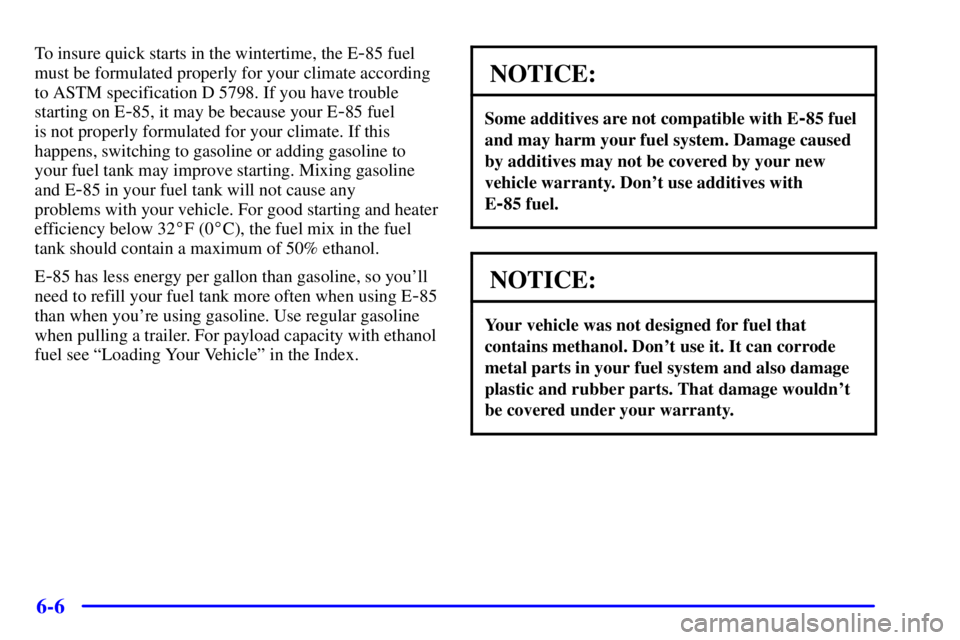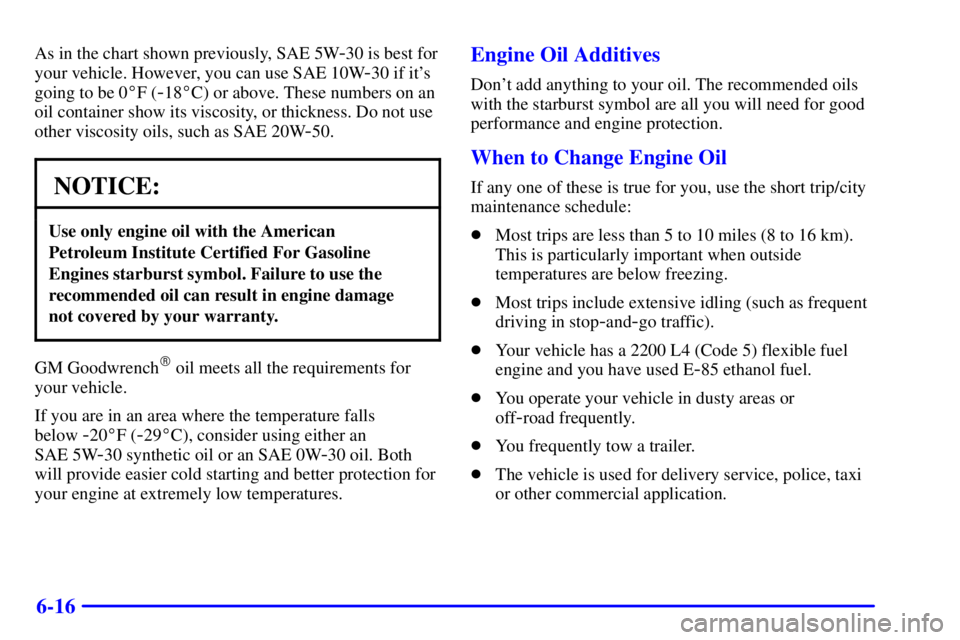Page 270 of 407

6-5
To provide cleaner air, all gasolines in the United States
are now required to contain additives that will help
prevent deposits from forming in your engine and fuel
system, allowing your emission control system to
function properly. Therefore, you should not have
to add anything to the fuel. In addition, gasolines
containing oxygenates, such as ethers and ethanol, and
reformulated gasolines may be available in your area to
contribute to clean air. General Motors recommends that
you use these gasolines, particularly if they comply with
the specifications described earlier.
NOTICE:
Your vehicle was not designed for fuel that
contains methanol. Don't use it. It can corrode
metal parts in your fuel system and also damage
plastic and rubber parts. That damage wouldn't
be covered under your warranty.
Fuel E-85 (85% Ethanol)
The 8th digit of your vehicle identification number
(VIN) shows the code letter for your engine. You will
find the VIN at the top left of your instrument panel.
See ªVehicle Identification Numberº in the Index.
If you have the 2200 L4 (Code 5) engine, you may use
either regular unleaded gasoline or ethanol fuel up to
85% (E
-85); also see ªFuel (Gasoline)º listed
previously. If you have the 4.3L V6 engine use only
regular gasoline.
Only vehicles with the 2200 L4 (Code 5) engine may
use 85% ethanol fuel (E
-85).
Most service stations will not have an 85% ethanol
fuel (E
-85) pump available. Those stations that do
have E
-85 should have a label indicating minimum
ethanol content. Do not use the fuel if the minimum
ethanol content is greater than 85%. Your vehicle
may not operate properly if the ethanol content is
greater than 85%.
At a minimum, E
-85 should meet
ASTM D 5798 specifications.
Page 271 of 407

6-6
To insure quick starts in the wintertime, the E-85 fuel
must be formulated properly for your climate according
to ASTM specification D 5798. If you have trouble
starting on E
-85, it may be because your E-85 fuel
is not properly formulated for your climate. If this
happens, switching to gasoline or adding gasoline to
your fuel tank may improve starting. Mixing gasoline
and E
-85 in your fuel tank will not cause any
problems with your vehicle. For good starting and heater
efficiency below 32�F (0�C), the fuel mix in the fuel
tank should contain a maximum of 50% ethanol.
E
-85 has less energy per gallon than gasoline, so you'll
need to refill your fuel tank more often when using E
-85
than when you're using gasoline. Use regular gasoline
when pulling a trailer. For payload capacity with ethanol
fuel see ªLoading Your Vehicleº in the Index.
NOTICE:
Some additives are not compatible with E-85 fuel
and may harm your fuel system. Damage caused
by additives may not be covered by your new
vehicle warranty. Don't use additives with
E
-85 fuel.
NOTICE:
Your vehicle was not designed for fuel that
contains methanol. Don't use it. It can corrode
metal parts in your fuel system and also damage
plastic and rubber parts. That damage wouldn't
be covered under your warranty.
Page 281 of 407

6-16
As in the chart shown previously, SAE 5W-30 is best for
your vehicle. However, you can use SAE 10W
-30 if it's
going to be 0�F (
-18�C) or above. These numbers on an
oil container show its viscosity, or thickness. Do not use
other viscosity oils, such as SAE 20W
-50.
NOTICE:
Use only engine oil with the American
Petroleum Institute Certified For Gasoline
Engines starburst symbol. Failure to use the
recommended oil can result in engine damage
not covered by your warranty.
GM Goodwrench� oil meets all the requirements for
your vehicle.
If you are in an area where the temperature falls
below
-20�F (-29�C), consider using either an
SAE 5W
-30 synthetic oil or an SAE 0W-30 oil. Both
will provide easier cold starting and better protection for
your engine at extremely low temperatures.
Engine Oil Additives
Don't add anything to your oil. The recommended oils
with the starburst symbol are all you will need for good
performance and engine protection.
When to Change Engine Oil
If any one of these is true for you, use the short trip/city
maintenance schedule:
�Most trips are less than 5 to 10 miles (8 to 16 km).
This is particularly important when outside
temperatures are below freezing.
�Most trips include extensive idling (such as frequent
driving in stop
-and-go traffic).
�Your vehicle has a 2200 L4 (Code 5) flexible fuel
engine and you have used E
-85 ethanol fuel.
�You operate your vehicle in dusty areas or
off
-road frequently.
�You frequently tow a trailer.
�The vehicle is used for delivery service, police, taxi
or other commercial application.